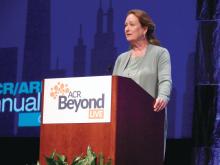CHICAGO – Treatment with transcutaneous electrical nerve stimulation led to a significant cut in pain during movement in women with fibromyalgia in a randomized, controlled trial with 301 patients at two U.S. centers.
The findings showed that, among patients assigned to self-administered transcutaneous electrical nerve stimulation (TENS) for at least 2 hours daily for 4 weeks, 44% had at least a 30% reduction in their pain with movement while on treatment, compared with 22% of patients reporting this level of improvement in the group that received mock TENS, Leslie J. Crofford, MD, reported at the annual meeting of the American College of Rheumatology. In addition, 29% of women who received active TENS reported at least a 20% drop in fatigue plus at least a 30% cut in pain, compared with their baseline levels, whereas this level of response occurred in just 13% of women who self-administered mock TENS.
The findings showed that “TENS can safely be used in addition to other treatment to improve pain and fatigue in women with fibromyalgia,” said Dr. Crofford, professor of medicine and director of rheumatology and immunology at Vanderbilt University, Nashville, Tenn. A total of 70% of women in the actively treated group reported they felt better on a global rating of change after 4 weeks of self-treatment, compared with 30% of women in the mock-control arm.
TENS, which uses a U.S.-approved device to deliver a defined series of electrical pulses to, in this case, the cervical and lumbar spine regions during activity, also showed no signs of inducing tolerance in the study and in fact produced results suggesting cumulative benefit with chronic use while causing “minimal” adverse effects, Dr. Crofford said.
“We did this study because we thought that previous studies of TENS had been inadequate,” she explained.
“Until now, most studies of TENS have been null. This was a uniquely positive trial,” commented David T. Felson, MD, professor of medicine at Boston University.
“The size, rigor, patient selection, and the TENS parameters may have been important” for the positive results, Dr. Crofford suggested. The 300-patient study was roughly 10 times larger than prior studies of TENS, and the current study used a “very vigorous placebo,” a TENS device that delivered a mock electrical stimulus. The electrical pulses used during TENS can vary by amplitude, duration, frequency, and pattern, and the settings for each of these parameters used in the trial came from prior clinical and animal studies of TENS.
“Once our study is reviewed and published, we will post our effective TENS parameters on our website. Most TENS units are adjustable” for these parameters, Dr. Crofford said. “Some of the parameters are probably important for avoiding tolerance, so it’s important to use the parameters that we’ve shown are effective.”
TENS “is available, safe, and very well tolerated. It has the potential to change practice immediately. If you look at the effect size and number of responders, TENS treatment is comparable to drug treatment,” Dr. Crofford said in an interview. A quarter of the patients in the study were on opioids at baseline, and the effect in this subgroup was similar to the overall findings. The women in the study were an average age of 46 years and had been diagnosed with fibromyalgia for an average of 7 years. Their average body mass index was 34 kg/m2.
The FAST (Fibromyalgia Activity Study with TENS) trial enrolled women aged 18-70 years who met the 1990 criteria for fibromyalgia (Arthritis Rheum. 1990 Feb;33[2]:160-72) who had not received TENS during at least the prior 5 years and scored at least 4 on pain rating during the prior week. The study randomized 103 women to receive active TENS, 99 to receive mock TENS, and 99 to receive no TENS. Patients in the TENS arms received instructions to use it for at least 2 hours a day when they were active. The study’s primary endpoint was the between-group difference in pain during a 6-min walk during TENS treatment. When measured after 4 weeks of at-home treatment, patients on active TENS had an average pain level of about 4.5 on a scale of 0-10, compared with an average score of about 5.5 among the mock-TENS group, a statistically significant difference. Both groups had essentially identical pain scores of about 6.5 at baseline.
FAST did not receive commercial funding. Dr. Crofford and Dr. Felson had no disclosures.
SOURCE: Crofford LJ et al. ACR Annual Meeting, Abstract LB19.



